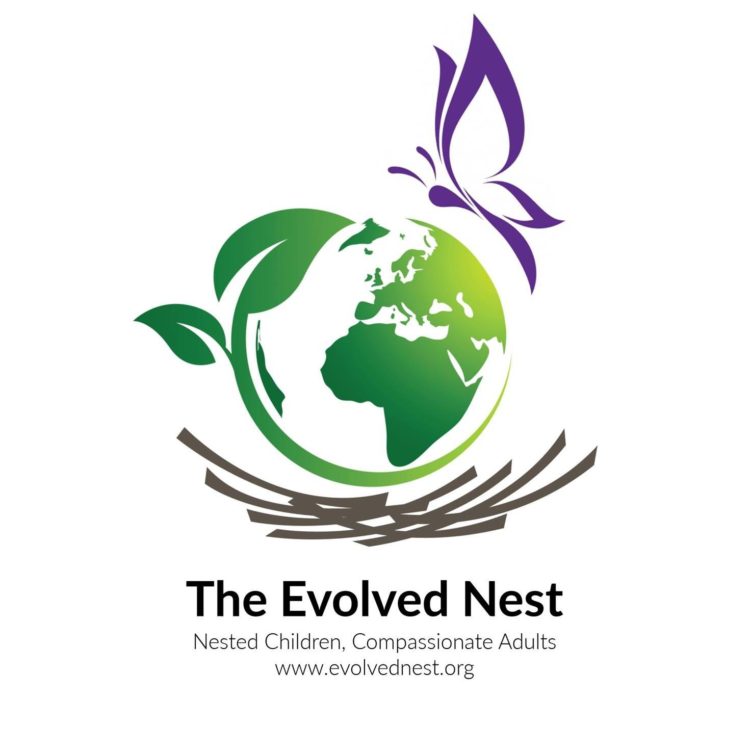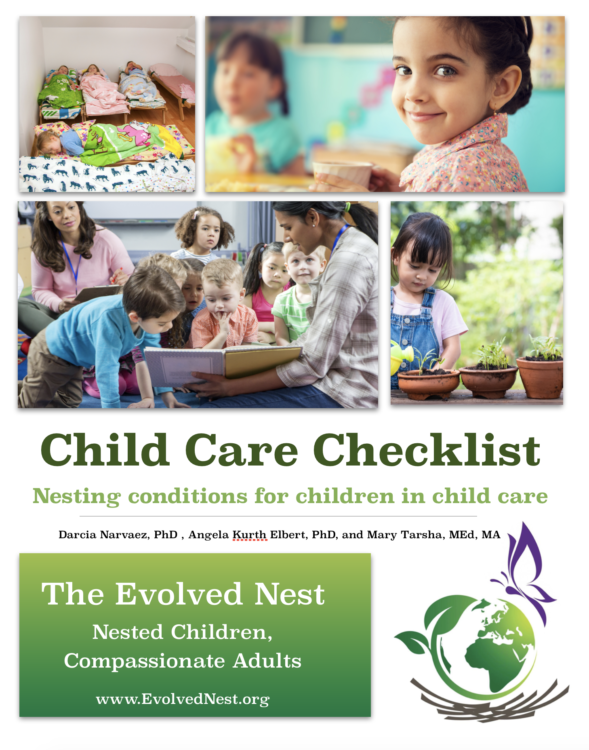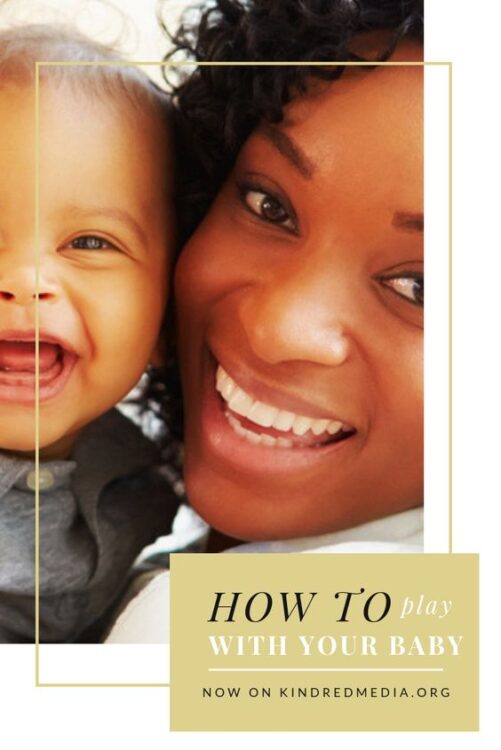The Evolved Nest provides guidance for evaluation.
With the pandemic and white-collar employees working from home, there are increasing calls for government-funding of child care to support parents in the workforce, especially mothers, who are falling behind their male colleagues in career advancement because they can’t get their expected work done when supervising children 24/7.
Of course, working mothers are not new outside of the middle class, who historically often had family members caring for young ones. And of course, it would be better to have extensive paid parental leave. The USA is the only one among 41 nations with no paid parental leave.
With mothers expecting and expected to work outside the home, the need for child care has never been so widespread. But the calls for child care often skip over discussing the exact nature of the care provided. What does quality care look like for young children? It’s about more than staff numbers or schedules. Much more is needed to prevent early life stress.
Early Life Stress
Communities are coming to realize that children should not be exposed to early life stress because it can have long term effects on health and wellbeing. For example, adverse childhood experiences (ACEs; Felitti & Anda, 2005) are often documented as family adversities like divorce and addiction, as well as personal adversity within the family like physical, sexual, or emotional abuse. Avoiding the harms of ACEs is important, but more is needed for babies and young children.
There are other stressors that babies and young children can experience that are also adverse. Early life stress is toxic—fostering short and long term problems—so one must understand how to prevent distress to young children.
Without an understanding of young child development and their basic needs, particularly baby development and needs, lots of harm can be done to children that can undermine health and wellbeing for the long term.
The Needs of Babies (0-2.5 years)
Babies are highly immature at birth with only 25% of adult brain volume at full-term birth and resemble fetuses of other animals until 18 months of age (Trevathan, 2009). This means that much of their biological, psychological and social capacities are grown after birth when the brain is rapidly developing in the first few years of life. https://www.zerotothree.org/ Many physiological systems are shaped by the quality of care received during early sensitive periods, such as the stress response (Lupien et al, 2009).

What kind of care do babies need as a result of their high immaturity? Exterogestation, that is, ‘a womb with a view’ (Montagu, 1970). It means that the baby’s needs are met immediately, just as in the womb, so that they can go back to growing rapidly (early on, mostly while sleeping).
Babies are especially vulnerable to unresponsive care. A sensitive caregiver adapts to the needs of the baby, providing comfort, calming and reassurance quickly whenever needed. In this way, the caregiving can be described as not perfect, but as “good enough.” Clinicians have described what this looks like among mothers:
“Good enough” means that mothers start off with “a high degree of adaptation to the baby’s needs…[a] tremendous capacity that mothers ordinarily have to give themselves over to identification with the baby. Towards the end of a pregnancy and at the beginning of a child’s life, they are so identified with the baby that they really practically know what the baby is feeling like, and so they can adapt themselves to the needs of the baby in such a way that the baby’s needs are met.” (Winnicott, 1990, pp. 144-145)
With a quick response to needs, which is not spoiling the baby, the caregiver keeps baby growing in a healthy manner (Schanberg, 1995).
From a psychological perspective, what babies routinely practice, they become. If they routinely interact joyfully with a responsive caregiver, those systems will become enhanced neurobiologically—they learn to be joyous. If babies are left in distress, various physiological systems can misdevelop, leaving the child dysregulated, stress reactive and/or self-focused (Lanius, Vermetten & Pain, 2010).
Center Care for Young Children (0-6)
Caregivers of young children should understand that they are shaping a child’s immune system, endocrine system (e.g., oxytocin), stress response, brain development and personality (Narvaez, 2014). As much as possible, child care workers caring for babies should mimic a mother’s care.
What does a responsive care center environment look like for a young child? We have developed a checklist for care center features based on the evolved developmental niche or evolved nest (Narvaez, 2014). Converging evidence across the sciences are demonstrating the importance of each of these factors for optimizing normal development and avoiding early toxic stress.
• Responsive, companionship care keeps baby optimally aroused to enable rapid neuronal growth. Baby’s needs are met immediately, as an “external womb.” This physical, social and emotional support system from friend-like familiar others keeps the child feeling connected and confident, building secure attachment.
• Affectionate touch (holding, carrying, rocking) which in our ancestral context, is nearly constant in the first years of life as physiological systems are setting their parameters of how well they will function, the psyche is figuring out its nature and place in the world. No negative touch—rough handling, pinching, slapping spanking, etc.—as this throws off the child’s optimal developmental pathway. Positive touch optimizes multiple systems like the stress response, the oxytonergic system, and the vagus nerve—which innervates all major body organs. Corporal punishment derails the development of self-regulation and social skills. Practices of routinely leaving babies alone in playpens, cribs, carriers instead of in arms have effects on growth and systems reliant on touch.
• A positive social climate where the child feels welcomed and like they belong to a community. Isolation and loneliness plague many people in the USA where babies are often sent to day care centers with rotating strangers, which harms their social development. A positive climate respects the dignity of the child (see Respecting Babies and Young Children
• Self-directed free play with playmates of different ages builds executive functions (e.g., redirecting actions and plans, empathy and control of aggression) and leadership skills. Children who do not experience whole-body play may be restless and unfocused, which adults may interpret as a need for pharmaceuticals.
• Nature immersion and ecological attachment so that the child builds biophilia–feels like a member of the earth community with responsibilities to non-human members. Societies that emphasize these practices foster nature’s biological diversity.
Partnership societies historically, typically matrifocal, focus on meeting the basic needs of their members, especially the young (Eisler & Fry, 2019). Such societies are not coercive but allow each individual to find their way and their gifts with supportive care, role models and stories, expecting self-determination in such a milieu to foster a virtuous character (Lavell-Harvard & Anderson, 2014).
The care a young child receives is critical for the type of trajectory they take—towards optimal wellbeing or not, towards long term resilience, or not. Early childhood care centers should be central to cultivating children’s wellbeing.
Click here to see the checklist we have developed for parents to determine how much a child care center matches up with the Evolved Nest.
REFERENCES
Eisler, R., & Fry, D.P. (2019). Nurturing our humanity. New York: Oxford University Press.
Felitti, V. J., & Anda, R. F. (2005). The Adverse Childhood Experiences (ACE) Study. Atlanta: Centers for Disease Control and Kaiser Permanente.
Lanius, R. A., Vermetten, E., & Pain, C. (2010). The impact of early life trauma on health and disease: The hidden epidemic. New York, NY: Cambridge University Press.
Lavell-Harvard, D.M., & Anderson, K. (2014). Mothers of the Nations: Indigenous Mothering as Global Resistance, Reclaiming and Recovery. Bradford, ONT: Demeter Press.
Lupien, S.J., McEwen, B.S., Gunnar, M.R., & Heim, C. (2009). Effects of stress throughout the lifespan on the brain, behaviour and cognition, Nature Reviews Neuroscience, 10(6), 434-445.
Montagu, A. (1986). Touching: The human significance of the skin. New York: Harper & Row.
Narvaez, D. (2014). Neurobiology and the development of human morality: Evolution, culture and wisdom. New York, NY: W.W. Norton.
Schanberg, S. (1995). The genetic basis for touch effects. In T. M. Field (Ed.), Touch in early development (pp. 67-80). Mahwah, NJ: Erlbaum.
Trevathan, W.R. (2011). Human birth: An evolutionary perspective, 2nd ed.. New York: Aldine de Gruyter.
Winnicott, D.W. (1990). Home is where we start from: Essays by a psychoanalyst (compiled and Ed. By C. Winnicott, R. Shepherd, M. Davis). New York: W.W. Norton & Co.



